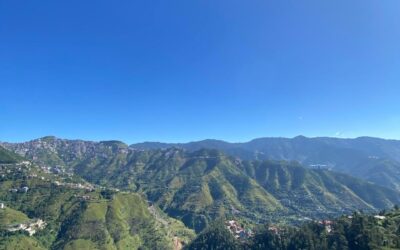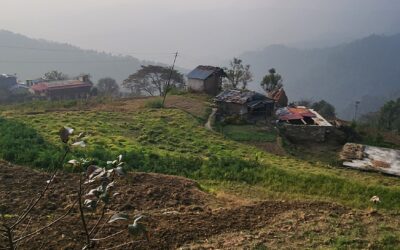One of the farthest schools from Kandbari in Panchrukhi education block is Rajot. I recall saying a few months ago that I had to hold on tight to my excitement of conducting a class during the hour long ride it takes to reach the school along the narrow winding roads. Seven months of taking this route every week it has grown on me. Visiting Rajot and Rajpur on Thursdays with my co-fellow, Simran, is a ritual that I look forward to. While singing along to each other’s playlists accompanied with a lot of gibberish (often meaningful musings) we are parked in front of the school before I know it. On most days we share a word or two with the teachers before we engage the students.
On that cloudy Thursday morning, we reached just in time for my class. I grabbed my box of teaching learning material — an Aavishkaar signature add-on — and entered the classroom right after the bell rang.
“Class stand! Good morning, didi,” chorused my bunch of ten young troopers in their singsong voices. I greeted them with a more dramatic mimicry of their tone and a wide smile. As they giggled while settling into their seats I observed the shift in mood because of sharing a quick yet genuine smile. Before I said anything else they started chiming one by one that they had done their homework. How often have you seen kids excited about homework? I remember my classmates avoiding meeting the teacher’s eyes out of fear and often dislike for their homework. I usually check my students’ notebooks by visiting every desk and ensuring their answers are the same as we had discussed in the previous class. This is easy because I have only five desks to hover over and ten notebooks to look at. Today I told I trusted them. I will take their word and not check homework (I had planned a surprise test instead to assess their understanding).
I made them sit down, clear their desks and relax. They told me what the classroom norms were one at a time. I instructed the kids to keep their hands on the table and take a deep breath. Hold it and release slowly. We repeated this thrice. Since it was our last class on symmetry, I told them to recall all the discussions we had since the first class. Where were the instances we discussed where we observe symmetry? In nature, monuments, buildings, art, geometric shapes and script. I wanted them to visualize all of these examples using their mind’s eye. I asked them if they saw something we hadn’t discussed in class yet. We focused on breathing some more and came back to our classroom.

Balancing the energy in the room
Shivam was absent. Avanshika was left alone without a partner. I asked who wants to have Avanshika in their team and all the kids jumped up. Teamwork and helping each other out is one of the abilities that we hope to build in a classroom along with curiosity, eliminating hesitation to question and thinking critically. I said that Avanshika could join Aryan and Palak’s team as she sitting in front of their desk. Aryan and Palak switched their seats on their own to share their bench with Avanshika. I appreciated their willingness to co-operate and work within the team. These were the same kids who clung to the opposite walls of the classroom when paired with a different gender when I started working with them seven months ago.

This is a Sierpinski triangle
We completed our fractal art which was due since the previous two classes. Aryan forgot to bring his fractal. We had only eight Sierpinski’s triangles. I wanted at least nine to make the activity work. I improvised by adding one triangle that I had. I hastily made a quick attempt to fill in the intricate pattern while the kids were cutting out their triangles. Since I had excluded Shagun for misbehaving in the previous class, I gave him the new triangle to colour. He was so happy! Palak willingly gave her triangle to Aryan for cutting out because he didn’t have one.
Then all kids gathered at the table and made several designs from these triangle: a giant triangle (they called it a pyramid), a hexagon, parallelogram, a flower, rocket, house and a fish to name a few. They finalized a flower after everybody voted in its favour as their favourite design. Everybody lent a hand to paste the triangles together with tape and put it up on the classroom’s wall. The kids were delighted to keep to in their classroom.
I wanted to use ‘exit slip’ because it was my last class on symmetry. Exit slip is a simple check for understanding at the end of a lesson where students are supposed to answer a fundamental question on a small slip and submit it with their names on it. This was a suggestion from an observer in my class last week. It is simple to implement and a quick assessment to find if the objective of the lesson is met. But I chose to focus on the positives and cherished them instead of being overly critical of myself. I had the upcoming Science class to use exit slips and many classes more to come.
Teaching these kids Math and Science for a few months could bring such a big change in their attitudes. I fear it won’t sustain when they start studying in seventh grade. They may have changed their behavior in my classes but continuing doing so without constant reinforcement is unlikely. I was their teacher for half of their academic session but my influence wasn’t limited to what I did in their classes. A lot of people had touched their lives. It was a constant cycle of reflection and improvement that led to this day. Uncountable inputs from observers, observing experts teach, visiting my peers’ classrooms, online teaching related courses and training and of course the relationship that I had built with the students and teachers over time and a lot of patience made it happen.
It was no coincidence that this incident happened only after I had stopped doubting my ability and learned to accept compliments with grace.




0 Comments